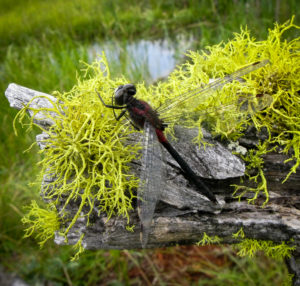 The Montana Natural History Center offers an array of Master Naturalist classes. Once you have completed the intial Master Naturalist series, you can continue your education through a yearly offering of specialized topics. Last week I went on a day long field trip to study dragonflies and damselflies. Of course, every time I’m around water in the summer I can’t help but notice these large insects whizzing by and flitting from plant to plant, but I never realized the diversity of what I was seeing. Two or three different colors, the difference in size between a dragonfly and a damsel fly, maybe. But I was astonished to learn that in Montana alone there are 91 different species, 57 dragonflies and 34 damselflies.
The Montana Natural History Center offers an array of Master Naturalist classes. Once you have completed the intial Master Naturalist series, you can continue your education through a yearly offering of specialized topics. Last week I went on a day long field trip to study dragonflies and damselflies. Of course, every time I’m around water in the summer I can’t help but notice these large insects whizzing by and flitting from plant to plant, but I never realized the diversity of what I was seeing. Two or three different colors, the difference in size between a dragonfly and a damsel fly, maybe. But I was astonished to learn that in Montana alone there are 91 different species, 57 dragonflies and 34 damselflies.
Our guides for the trip, Bob Martinka and Nate Kohler are men obsessed with the order, Odonata, which means ones with teeth. This is because these insects are carnivorous, consuming the insects they catch in mid-light by chewing them to mush in their It is one thing to learn the facts about dragonflies, that their eyes have plus or minus 7,000 lenses, or that they have been around for more than 250 million years, predating the dinosaurs, or that their wings, because they are attached to their bodies by separate muscles, can move independently, which means that they can fly backwards as well as forward, upside down, dive, hover, pivot in a circle and fly up to 30 miles per hour.
But information like that is available to anyone with the click of a mouse. What I took away from the field experience was the infectious enthusiasm for Odonatas that our guides demonstrated. They shared how the desire to find and identify different species can send the naturalist out into far-flung wildernesses and hidden potholes and tarns. No book or web page can give you the experience of being in the field with someone who opens up a world of wonder. Reading cannot give you the sense of slogging through a bog, the feel of walking on sponges suspended in water with the possibility of breaking through at any moment. A list of facts cannot substitute for what it’s like to search the insect filled air for a dragonfly or damselfly and the skill to get just the right swipe, with a twist of the wrist to secure them in you net.
I would never have thought it possible to hold a dragonfly in my hand until Bob showed me how to gently grasp their wings between my thumb and forefinger and peer into their multi-faceted eyes. They taught me how to look for all the identifying markings that will tell you what species you are holding.
And then, having caught their infectious curiosity and enthusiasm, I am off on my own, discovering the place in the tall grasses where the tiny sedge sprites are perching, or seeing, as I track them with my net, how the Dancers bounce around, a little spastically, in flight and flick their wings when they perch, giving me that aha moment as I connect their name to their flight pattern. As I spent the day immersed in the Odonata world, I I began to catch a glimpse into the world Leslie Marmon Silko conveys in Ceremony:
“Dragonflies came and hovered over the pool. They were all colors of blue–powdery sky blue, dark night blue, shimmering with almost black iridescent light, and mountain blue. There were stories babout the dragonflies too. He turned. Everywhere he looked, he saw a world made of stories, the long ago, time immemorial stories, as old Grandma called them. It was world alive, always changing and moving, and if you knew where to look, you could see it, sometimes almost imperceptible, like the motion of the stars across the sky.”
